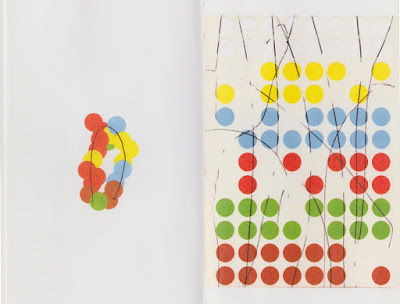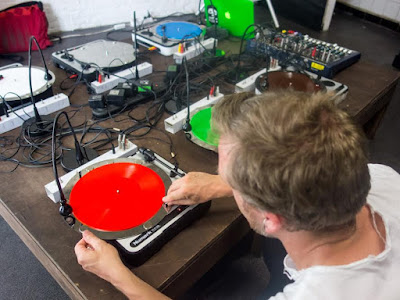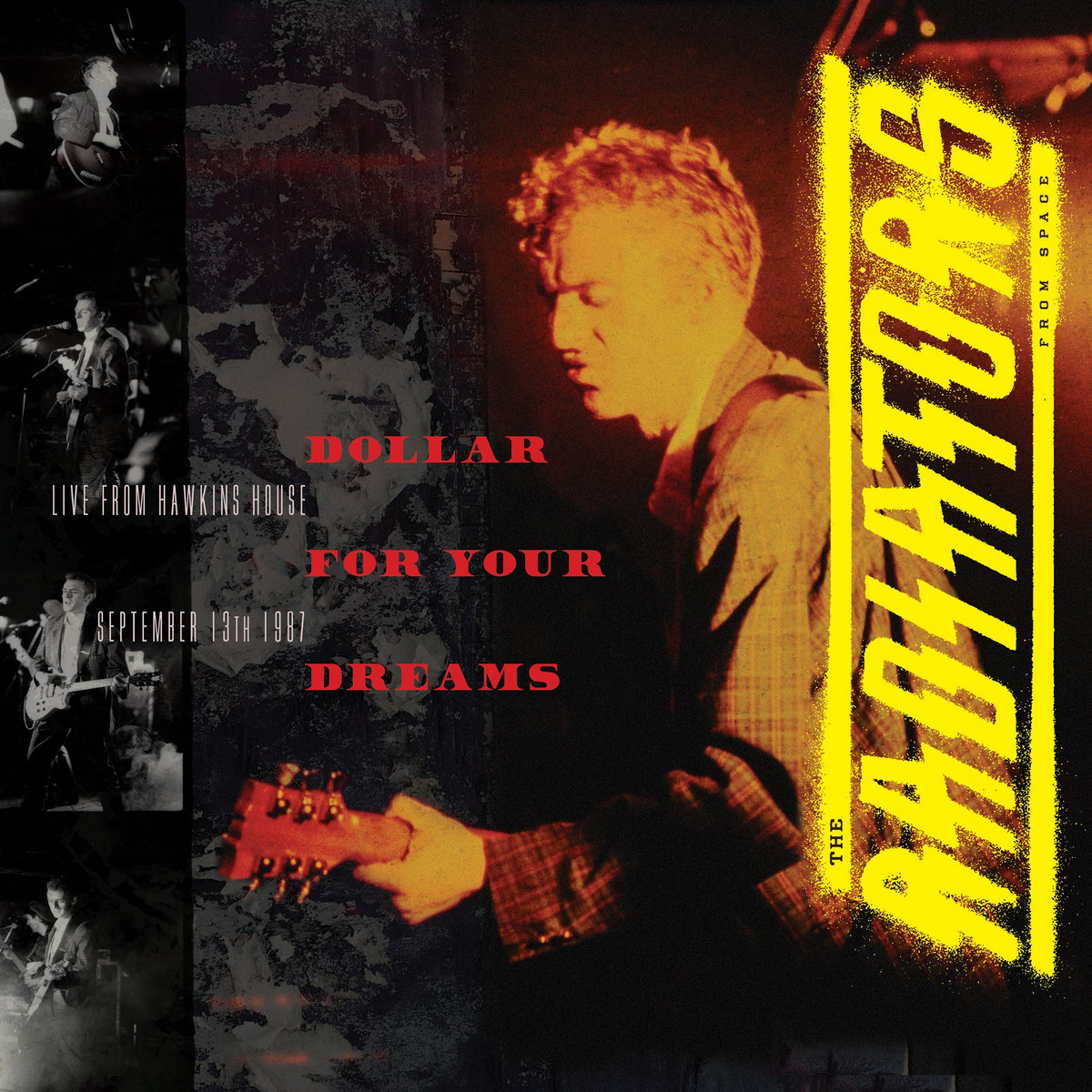Remörk aka Kris Delacourt
A live recording of a pretty weird DJ set
Remörk’s head scratching debut album ‘Principium 2.1’ could have easily crashed under its own weight, too full of ever changing versions of the same idea. But it didn’t.
I’ve been following the principium story on your blog, which goes back to the summer of 2012, so four years ago. Short version: first it was a one octave Casio keyboard, then it became 12 10″ records, then it became an 8 hour performance and eventually now a 12″ LP. This is the short version, can you give me the full story?
Kris Delacourt: Well actually, it started out as an artwork, or rather a series of artworks. At least that’s where the initial form and the name came from.
The works are by a friend of mine, the Belgian artist Vaast Colson. He made these beautiful pieces where he used tiny paper sticker dots, you know the ones, the kind that most art galleries use to denote which works in a show have been sold. Office material really, those colourful little dots.
What he did was draw a bunch of random lines across the sticker sheets, and since there’s 8×12 stickers on a sheet you end up with stickers with tiny line segments on them. Line segments he reassembled into new shapes and new lines. It’s all pretty nonsensical in a way I guess, especially if you try to put something like that into words, but it’s also really beautiful, and quite fragile. Don’t know, it just rang poetic to me.
Anyway, Vaast was putting together a show where other people would do reinterpretations of some of his works, and around the same time we had a nice chat about alternative musical scores, graphic scores and what not. And at a certain point he went something like: ‘I’ve made some work that might be interesting to use as a score, would you be up for it?’. So he showed me the two booklets he made with the Principium series – reproductions of each used sticker sheets and the result. The funny thing was that he thought his resulting collages would be nice to use as scores – and they probably would be, it’s just that I was so intrigued by the leftover sticker sheets, with their 8×12 grid that just scream ‘SEQUENCER!’, that I went that way.
And the first version was indeed a modified Casio keyboard. I reduced the number of keys to twelve, and added a magnetic sequencer board to it. It’s an iron board, it has the same visuals as the sticker sheets, and the idea is to put white magnets on top of the coloured dots to kind of blank them out, so you end up with something analogous to taking a sticker off the sheet – a white space in a field of colour. I don’t know if I need to go into too much technical detail, but the sequencer controller is just a reed switch matrix that, when a magnet is present, allow step pulses to pass to digital switches that bridge the original Casio keys.
I was really happy with the results, and especially with the fact that it’s so inviting towards an audience. It looks like a game of four-in-a-row, totally appealing to get your hands on it. And I never gave it that much thought, but the fact that when you stick magnets somewhere, it makes a musical phrase – I guess to some people that would be wizardry, hah.
The next step was when Peter Fengler of DePlayer/DOB records said he wanted to do a record with the Casio version. And I really like it when people are enthusiastic, so I said yes, obviously. But there were several reasons for me to hold back a little on the idea. Well, a little, two years, actually. First is that the Casio version really works best through audience interaction – people moving magnets around, changing the sounds on the keyboard and so on. It’s meant to be in a continued state of flux. The idea of just me making a record totally ignores that, to me it turns it into something really static and rigid. Now Peter is really nice guy, and clever at that, and I guess he understood my doubts. So we discussed other possibilities, like capturing a live performance, possibly even cutting records on the fly with his vinyl lathe, so you end up with all different records.. now DOB records have put out some crazy releases, really pushing the boundaries of what can be done with the medium of vinyl. For example, there’s this box set which has records that have built-in radio transmitters, records with impossible shapes where you need to turn the stylus of your record player upside down, shit like that. Really great stuff. And I don’t know, maybe a part of me wanted to be a part of that, more than just doing a ‘recording’. Just recording the Casio would definitely have been one of the safer, more boring options. I just felt like making another interpretation of an existing piece, instead of merely documenting it.
Meanwhile I had been toying around with leftover magnets and magnetic sensors, sticking magnets to a metal turntable platter and using the sensors to switch audio on and off, sort of like a programmable tremolo. Well, pattern programmable, but at a fixed speed. So we put two and two together, and ended up doing twelve 10” lathe cuts, that came in a box with those electronic switches, 8 magnets each as based on the original grid, and a 12” metal platter to go under the 10” to stick the magnets to.
And because I couldn’t make up my mind about what sounds to record from the Casio, I ended up not recording the Casio at all. I decided to stop worrying, which after two years of doubting might not be such a bad thing, and did a 10 minute improvised recording on organ and MS20, playing only C notes. I played around with filtering and octaves, because during testing we’d found that if we used slowly evolving records, the results were a lot more interesting. If we just used test tones, so to speak, you end up with something close to morse code. Also nice, but not really musical. And I don’t mind a good concept now and then, but I guess I’m too much of a musician, so I went for what was more appealing to me musically. That same 10 minute piece then was sped up for the other notes, going up in pitch and becoming shorter for each record. So the C note runs for 10 minutes, the B note is something like 5 minutes 20. Which also makes for much more interesting overlaps when played together. I guess I do tend to overthink things, hah. Peter did a great job cutting the vinyl in coloured perspex, with colours matching the paper stickers. And an honourable mention to Koos of DOB who did an amazing job on designing the packaging.
Vaast and Dennis Tyfus of Ultra Eczema run a space in Antwerp together called Stadslimiet, and that’s where we had the record presentation. Peter brought 6 record players, matching the 6 colours of the vinyl nicely – 2 notes each. And since I’m a sucker for random scores, I wrote myself a score generator in PureData with tons of random functions. Basically, the program decided for me which records to play, whether to repeat them or not when they were finished, whether to leave the turntable empty, whether the electronics should punch holes in the sound when a magnet was detected or the opposite, how may magnets on each turntable, and playback volume. The only thing I had any control over was where to put the magnets, determining the rhythm. And since all the records have different lengths, it ended up being one long shifting overlapping piece. I followed that score for 8 hours straight. Funny thing was that we’d agreed to let it run until 23h, and at about two minutes to eleven I got the first ever instruction to leave all the turntables empty. End of piece. That was an amazing moment.
After that, Dennis asked me if I wanted to do a release of the recordings. I think initially he wanted to do a tape. So I went through 8 hours of recordings, selecting bits that I liked and that I thought would be interesting enough to listen to as pieces in their own right, and not just as part of this monster performance. I think the idea to make a vinyl record came after Dennis heard some of the selections and thought they shouldn’t be out on tape but on vinyl instead. So that’s what happened.
Is this LP the final version of this project, or do you see it even evolve into next stages?
Oh, I think it’s definitely something that’s still evolving. I can still see unexplored possibilities there – as an installation, or as a truly playable musical instrument, and even those two do not have to be mutually exclusive. There’s something appealing in using a single octave as a building block, there’s something appealing in the number 12 even, there’s the appeal of building instruments.. I don’t think I’ve quite finished with it, no.
Dennis said you were not really keen on doing this record at first. Why so? What was the problem? Was one of your fears that, by making it into a 12″, you would have to bring this project to a final version?
Not really, at least not in this case. I guess that fear was much more of an issue with DOB records. Recording the Casio felt too definitive at the time.
But now, having made that 12-vinyl version, and having done a performance that worked quite well, I didn’t mind starting from what is essentially the documentation of a past event. Also because I really am convinced that this is just one more step in something that can keep going, that it doesn’t have to be final. I guess my main fear was that cutting chunks out of a much larger whole, you risk losing the context – and I’m still not sure what this record sounds like to people that weren’t there. I know it’s not a final version, but it is a version nonetheless, and I want all versions to be of a certain quality. I thought it worked really well as a performance, but I wanted to make sure it was good enough to be a record.
Bringing an 8 hour performance back to an album format seems like a hell of a job. How do you do that? How do you decide which parts ‘work’ on an album, and which don’t?
You do it in short sessions, hah. The thing is, all 8 hours have the turntables spinning at 33 rpm, so the basic underlying tempo never changes. That’s quite brutal to listen to in concentration, to be honest. It took me about two months to sit through all eight hours, and put markers and comments with bits I liked more than others. Sometimes because of harmonic information, notes that work well together, sometimes of rhythms that worked well, etc. So you end up with a first rough selection. And then you go through that selection again. And so on, until you really narrow it down.
Of course, because the basic tempo is the same, it would have been relatively easy to start editing, splicing things together. But to be honest I’ve never even considered that – 8 hours of material and endless editing possibilities, that’s a nightmare.. the decision to have straight up documentation, just select bits instead of editing them some more, really made the selection process easier. If something was interesting for a while, but didn’t stay interesting, it had to go. I think I ended up with five or six pieces that I though could hold their own on a record, four of which made the final cut.
Do you think that, by bringing it back to an LP, you’re making it easier for the listener? Were there people who actually listened to the whole 8 hour performance? Do you think that listening to an 8 hour performance demands another kind of concentration from the listener than listening to an LP?
There were some people there that sat through the whole thing, yes. But I’m not sure if it is at all possible to listen with concentration to 8 hours of something like this. And that was never the question either. It was continually shifting, so it didn’t really have a beginning or an end – you could drop in any time you liked. But it was pretty intense, so yes, this record is probably the light version. Still, not sure if it is easy listening at all, although I think it has a beauty of it’s own.
Weren’t you afraid at some point that this whole idea would grow over your head, that it would become too complicated, too smart, too conceptual?
I guess there was the point where I decided to just do a 10 minute organ improv, that was a bit of a turning point. I could have gone for something more ‘correct’ in terms of concept – I don’t know, pure sine waves or something. The improv might be one of the major flaws, actually, conceptually speaking. But I really needed a break from thinking it over and just do something… plus, it adds a much needed layer of spontaneity that works beautifully, not in the least musically, so no regrets. I like working with concepts a lot, as a starting point, but I’m also interested enough in the results to loosen up the concept if I feel it’s needed.
I could say that the 10″ records were vinyl records as a tool, and that this LP is a vinyl record as a product. What you think about this statement? How do you look at the function a piece of vinyl can have?
The 10” records have all been sold as well, so they’re somewhere on middle ground – they were intended as a release, and therefore a product, just as well.
But they do form one big piece, and as far as final forms go, I guess you could consider that performance the final form of that particular piece. That’s also purely pragmatical: now they’ve all been sold, it’s going to be very difficult to get all 12 of them together again for a second performance. It really was a one time event, with the vinyls as a tool, yes. Of course, taking what is essentially a reproduction medium, and turning it into something of an instrument in it’s own right again, that’s nothing new.. think hip hop, turntablism, even things like the mellotron did that. But it’s still a relevant idea to me, this kind of creative misuse.
You release this album as a Remörk album, but there were more people involved in this project than just you: there’s Vaast Colson, Peter Flenger and Dennis Tyfus too. So do you see this album as a solo record or as a collaboration?
I do look at it as a solo thing. You know, the music on the record came from a performance I did, based on a concept I came up with. Now, I never would have though it up if it weren’t for Vaasts initial invitation, or for Peter’s asking me to do a record, or Dennis wanting to present it in Antwerp, that whole chain reaction, so in that way it’s definitely the result of collaborating with all those people. But Vaast for instance refuses to regard it as his doing. He always stressed, right from the start, that any interpretation I gave of his work was no longer his work. And I follow that. They’re just new pieces in their own right.
Peter and Koos asked me to do a record because they run a record label and they want to release stuff they think is interesting. That’s awesome, and I’m flattered to be a part of that, but in a way it’s also what record labels are supposed to be doing, no? We worked on the packaging together, and it looks amazing because of them. But musically, I still feel it’s my work. And the same goes for this record on Ultra Eczema: I have to say I’m really happy we finally got an Ultra Eczema release together, it’s something Dennis had been asking for for quite some time… he’d actually given up asking. But now with this thing it just seemed to fall into place perfectly.
When Joseph Beuys was asked why he hated the term ‘conceptual art’, he said: “Because a concept, an idea is a starting point, not a final form. If you stick to the concept, you miss out on the creative aspect, which should be the most important part. Otherwise you’re not an artist. Art is not pinning things down. Art is letting things go, let it flow”. Does this sound recognisable to you? And how would you relate this quote to your LP?
Not having to execute ideas into a physical and therefore flawed final form was the whole point of conceptual art, no? The notion that an idea can be just as valid and just as creative as its execution.. but anyway.
I for myself am always glad if I manage to turn an idea into a physical form. Did I mention I tend to overthink things? So I don’t think I belong in the conceptual art section. But then, I don’t fully agree that you miss out on creativity by sticking to a concept. Coming up with a concept can be as much a creative process. And sometimes, by sticking to it, you end up with the most unexpected results – adhering to rules you impose on yourself makes you do stuff you would never have decided for yourself. It can make you go against your natural inclinations, which does not always have to be a bad thing. It can free you from repeating yourself, from your own mannerisms. That’s just another way of letting things go, of giving up control.
The Ultra Eczema site refers to this record as your debut LP. Does it feel like that for you too: as your first ‘real’ album, as a statement?
I think I would consider that series of twelve ten inches my vinyl debut.. but maybe because it was 12 different records or in ten inch format, that it doesn’t really count? Or maybe Dennis thinks of that series as a tool more than a product. Still, the Ultra Eczema one is definitely the first record that is more widely available, and much more of a pure record than an artists’ edition, so I know what he’s saying. And a statement.. I don’t know. I don’t think of it as a manifesto or anything. It’s a document of what I’m happy to be working on at the moment, and hopefully it’s something that others can enjoy as well.
Do you see this as a drone record? Or as a collage record?
If you force me to choose between those two, then drone. I tend to associate collage records with cut and paste editing, jumpcuts, going from one atmosphere to the next in no time.. I don’t feel this record has that. Quite the contrary. The only thing remotely close to jumpcuts that are on this record were due to the electronics of the installation, the sensors turning the sound on and off. But they were live events, not editing choices made afterwards. So this is very much a straightforward live recording of a pretty weird DJ set, if you will. And even though it has strong rhythmic patterns, the underlying harmonies and atmosphere shift quite slowly. So more drone, definitely.
Do you think this LP would be also enjoyable if someone would listen to it without knowing a single thing about the whole concept behind it? Or do you even think you would have failed if it wouldn’t be an enjoyable record without the concept?
I certainly do hope that it’s enjoyable.. like I said, I know it’s not easy listening per se, and some might probably find it boring at first try, with the tempo being the same for the whole record and all. But I did try to select bits that I thought had a beauty or a strong appeal to them, an interesting evolution or whatever, so much so that I hope they can survive as musical pieces in their own right. aiming for the best of both worlds there.
– Joeri Bruyninckx
© Copyright http://www.psychedelicbabymag.com/2016
Array










